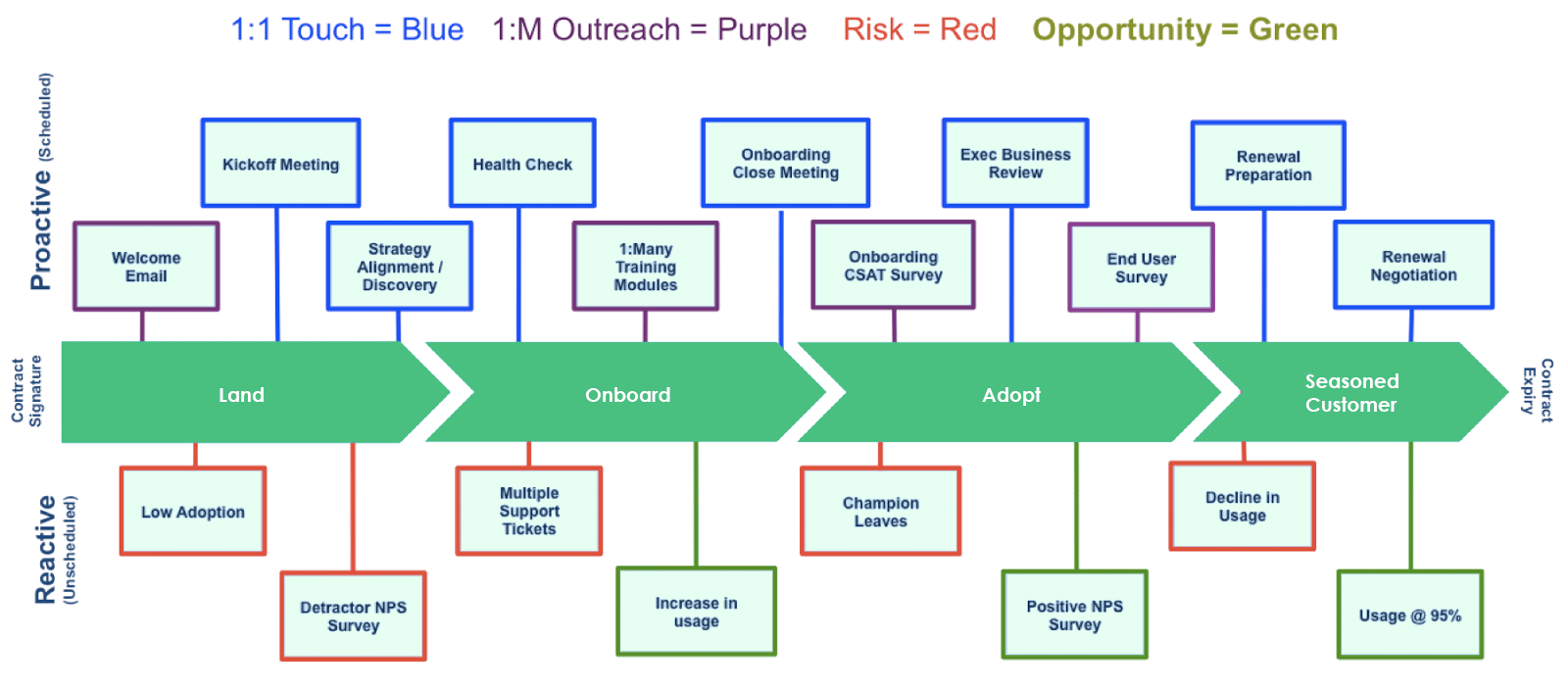How much do you know about the key responsibilities of a customer success manager (CSM) in SaaS companies?
Customer success is a relatively new field. Therefore, most companies don’t clearly understand these responsibilities.
However, this guide will give you more clarity on how hiring a customer success manager can increase customer satisfaction and lead to higher retention in your SaaS company.
What is Customer Success?
To understand the meaning of customer success, let’s answer this very important question. What’s the key to growing a SaaS business quickly and progressively? The secret is in your ability to acquire and retain customers, and that’s where customer success comes in.
Customer success refers to how your business helps customers achieve maximum satisfaction with your product or service. It is built on the premise that a win for your customer automatically translates to a win for your business.
Therefore, customer success is vital through every stage of your customer’s life cycle, from onboarding to retention and referral. Ultimately, it translates into more recurring revenue, which is the lifeblood of every SaaS business.
Read more: The Ultimate Guide to Customer Success in SaaS
Who is a Customer Success Manager?
A customer success manager is a person who is responsible to ensure that customers are successful with the purchase they make. They should ideally be engaged during the sales phase and post-sales own the relationship with the customer. They proactively work with customers to ensure that the objectives that the customer set out when they purchased the product are delivered.
An effective customer success manager focuses on creating strong relationships and fostering customer loyalty by ensuring that clients have a positive experience—especially after a sale.
What does a Customer Success Manager do in SaaS?
In SaaS, customer success managers are responsible for understanding the problem the customer is trying to solve with the product and ensuring the product delivers that value to the customer. They focus on ensuring that customers receive contextual help to have a positive user experience. This ranges from providing in-app help to improve onboarding to upselling the right features to trial users.
Customer success teams vs. customer support teams?
While it’s easy to confuse customer success with customer support, there is a major difference.
Think of customer support teams as short-term treatment plans. Customers come in only when they have a problem, and they assist in implementing a quick fix.
In comparison, customer success teams are more like long-term treatment plans. They take the time to understand how the customer’s body works and guide them through a journey to recovery. The goal is to sustain it over time. Customer support is reactive, while customer success thrives on being proactive.
Read more: A detailed comparison between Customer Support and Customer Success
Top SaaS customer success manager skills and qualifications
What makes a SaaS customer success manager stand out? The roles and responsibilities of customer success managers can be carried out successfully if they have these soft skills.
- Problem-solving: To help customers navigate challenging situations and come up with creative solutions to diverse issues.
- Communication skills: To ensure that there is no communication gap. This is a huge part of your job that involves direct interactions with customers.
- Empathy: To show that you understand the needs of your customers.
- Relationship management: To help build long-lasting bridges with customers. This shows that you truly care.
- Industry knowledge: To provide accurate and up-to-date information to your customers. This shows that you know their pain points and business models.
- Collaboration: To create thoughtful strategies that cut across several departments within an organization. These include marketing, sales, and support teams.
- Leadership skills: To lead your team through good customer success strategies. These strategies are designed to achieve goals faster and more efficiently.
- Technical skills: To gain a deeper knowledge of your product. This technical expertise will be effective whenever customers need your input.
Schedule a demo with one of our experts to take a deeper dive into Churn360
Book a demo
Customer Success Roles in SaaS
To build a strong customer success team, you should know what roles you need to hire for in your organization. Here’s an overview of customer success roles to consider when building your team.
- Customer success associate: An entry-level position for customer success.
- Customer success manager: They interact directly with customers to identify their goals and build strategies that other team members can work with to help achieve them.
- Senior customer success manager: Works closely with customers to ensure their continued satisfaction with your products and services. Typically high-value customers.
- Director of customer success: Oversees a team of customer success specialists focused on providing an enriching customer experience and fostering strong relationships with clients.
- Chief Customer Officer: A c-suite level position for planning and executing customer success strategies towards a better customer experience.
Read more: Roles in a Customer Success Team
10 Key Responsibilities of a SaaS Customer Success manager
Customer success managers are responsible for understanding customers’ goals and working towards achieving them. Here are the key responsibilities of customer success managers in SaaS that are crucial to the success of your brand.
Map a comprehensive customer journey to identify key touchpoints
Can you work towards improving your customer’s experience without understanding their journey? Short answer: no.
The role of the CSM is to map an overall customer journey to identify key touchpoints that occur along the customer’s journey. This could start from onboarding to adoption to renewal. Doing this makes it easy to clarify the current stage of the customer, the next milestones, and their end goal.
What’s more, a comprehensive customer journey map can help CSMs identify friction points with high user drop-offs. By identifying these paths, they uncover the shortest path to product adoption, which in turn leads to more recurring revenue for the company.
That said, here’s an example of a comprehensive customer journey map:

Create and optimize customer onboarding with interactive walkthroughs
One of the most crucial customer success responsibilities is creating a viable customer onboarding process. Because customer onboarding is a key factor for customer stickiness, customer success managers must prioritize improving the process until they get one that’s effective.
Unfortunately, many customer success managers make one common onboarding mistake. They take users through a long product tour where they don’t see your product solve a problem soon enough. And then the worst happens: churning.
However, guiding users on the shortest path to success will stop this from happening. For example, you can use in-app guides like tooltips to show users around once they sign up. Here’s an example of a tooltip in Hubspot:

Customers do not want to see all the features that your product has at once. Instead, they want to see the most relevant features that can help them solve their pain points. This is one of the responsibilities of customer success managers.
They have to personalize onboarding experiences for products that require a high level of customer success.
Churn management and customer retention
You’ve heard us mention churn over again, and there’s a good reason for that. Businesses lose as much revenue to it, and that’s why it’s a top responsibility for customer success managers to prevent churn.
As much as possible, customer success managers must ensure that customers become long-term users of your product. You can do this by tracking product engagement usage to identify drop-off points along the customer journey.
Then, address them quickly by deploying reactive and proactive churn management strategies to keep your customers.
This straight-forward guide on why users churn and what to do about it will give you more insight into the best ways to encourage brand loyalty.
Using a product like Churn360 can also help by calculating health scores for each customer and proactively showing which of your accounts you need to focus on more.
Collect customer feedback and act on it
What’s the best way to know if you have a healthy relationship with your customers and what areas to focus on? The golden rule is to ask questions. All relationships thrive when there is proper communication. This also applies to customer-business relationships.
As a CSM, your role is to collect feedback from customers to measure customer loyalty and satisfaction with your product. It also helps you identify where customers are getting stuck, and how to continuously improve our product.
There are many ways to collect valuable feedback from customers. For example, in-app surveys, NPS surveys, etc. Here’s an example of an NPS from Airtable:

This NPS survey is short and straightforward. Results from this will help in determining the level of satisfaction of your customers, and you can act on this.
Increase the customer’s lifetime value
As customers progress through every customer’s journey, the customer success manager needs to know how to increase the customer’s lifetime value. The key is understanding when to upsell, cross-sell, and encourage account expansions, thereby pushing toward long-term partnerships.
Yes, this sounds like a huge responsibility, but you don’t have to upsell all the time. Once again, knowing where your customer is on their journey map will ensure you know the right time to offer this. It boosts your chances of customer retention.
For example, several brands offer the upgrade option only when customers are about to exhaust the trial period. At this time, most customers have enjoyed the full value of the product, and if it’s great, they won’t want to miss out on this. So, there’s a high chance they’ll grab that upgrade option.
Educate customers to improve their experience
Fact 1: Happy customers are loyal customers.
Fact 2: Loyal customers are willing to drive referrals to your SaaS company.
So, how do you keep your customers happy? One of the biggest secrets to this is product education. CSMs are responsible to identify the right time to educate users in-app and when to step back.
The positive effect of this is the boost in customer satisfaction levels, which will lead to higher retention and, of course, more revenue. For example, you can educate customers with onboarding videos, just like Bit. They educate customers with a video embedded in a modal:

A huge percentage of Bit customers will be happy to check out that video as it increases their chances of having a positive user experience. And that’s the goal!
Build customer relationships and drive loyalty
Our discussion on the role of customer success in SaaS companies is incomplete without talking about customer loyalty and building relationships. Customer loyalty is an important sign that users have succeeded in using your product and are happy to continue.
Whereas other teams encourage loyalty through discount programs and rewards, the customer success manager responsibility is to focus more on making the overall product experience exceptional. This extra bit of personalized experience is what lets users know that you care deeply about their satisfaction, and let’s face it, everyone loves to be heard.
Create a customer success plan.
If you’ve ever heard the saying, “failing to plan is planning to fail,” you’ll understand why having a customer success plan is crucial in implementing your customer success strategies.
As a customer success manager, it’s your job to create a viable customer success plan to identify the goals and needs of your customers. Then, you can easily discover parts in your customer’s lifecycle where they find out how valuable your product is. Being able to map this perfectly is important in your quest to build loyalty.
Track customer success metrics and analyze them
A key role of the customer success manager is to measure key customer success metrics and analyze them. This way, you’ll know the areas to improve and where you’re getting it right.
Some important customer data to track are retention, net promoter score, customer engagement score, customer stickiness score, and churn rate. These help you measure performance and answer the important question, “Was my onboarding process a success?”
If the answer to this is positive, you know you’ve covered all the aspects of your customer success manager job description.
Collaborate with sales & marketing teams
As a customer success manager, you don’t work independently. In fact, your chances of success increase astronomically when there’s an understanding between you and other departments in the organization—especially the sales and marketing teams.
Regular communication with the sales team lets you know your customers as much as they do. You’ll stay updated on their needs, objections they are likely to have, and goals.
Liaising with the marketing team gives you more insight into the personas of your users. With this, you can better tailor your marketing strategies to fit your customers. It’s also a great idea to use customer success tools to collect valuable user data and automate various actions. They can come in handy in making collaborations across teams seamless.
Keep the Customer Success Platform Updated
There are so many communications that go back and forth, and updating a log of what has been communicated is a core responsibility of Customer Success Manager. This helps when you revisit the customer journey map after a small gap. And when you hand over the customer to another CSM, they have all the information in one place.
Keep track of your customer journey lifecycle
You can achieve true customer success by anticipating your customers’ needs and satisfying them before they request it. Not only does this increase customer satisfaction, but it also helps you stay ahead of competitors in your industry.
Now that you know the key responsibilities of a customer success manager, you need a customer success software to help you track customer lifecycle data through a viable customer success plan.


